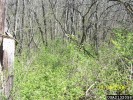- Created: 11 August 2010
- Updated: 16 December 2014
- Published: 11 August 2010
- Hits: 29994
 The main overgrowth of vegetation afflicting Roanoke Park is the non-native invasive bush honeysuckle* Lonicera maackii. This plant is native to Asia and was imported to our area as a landscape plant valued for it's fragrant spring honeysuckle blooms, fall red berries and utility as a screen. But alas, this plant has "escaped" with a vengeance, lining roadsides and invading parks and natural areas throughout Kansas City. Birds eat the berries and spread the plant near and far. Roanoke Park is not alone in suffering from an infestation but may be one of the spots where it can be effectively controlled with concerted effort. Control efforts are being undertaken in Hyde Park and Gillham Park and in parts of Swope Park and other properties where Kansas City Wildlands volunteers are at work. Homeowners and property owners are encouraged to remove it from their properties if at all possible.
The main overgrowth of vegetation afflicting Roanoke Park is the non-native invasive bush honeysuckle* Lonicera maackii. This plant is native to Asia and was imported to our area as a landscape plant valued for it's fragrant spring honeysuckle blooms, fall red berries and utility as a screen. But alas, this plant has "escaped" with a vengeance, lining roadsides and invading parks and natural areas throughout Kansas City. Birds eat the berries and spread the plant near and far. Roanoke Park is not alone in suffering from an infestation but may be one of the spots where it can be effectively controlled with concerted effort. Control efforts are being undertaken in Hyde Park and Gillham Park and in parts of Swope Park and other properties where Kansas City Wildlands volunteers are at work. Homeowners and property owners are encouraged to remove it from their properties if at all possible.
Bush honeysuckle is detailed further in this excellent publication from the Missouri Department of Conservation: Curse of the Bush Honeysuckles! Identification and control measures are discussed and many suitable landscape alternatives are shown.
What's so bad about bush honeysuckle?
Left unchecked, this plant has the capacity to produce a monoculture, meaning large stands or thickets where nearly the only plant growing is bush honeysuckle. It kills the native vegetation, depriving native insect and animal life of their homes and food sources. It manages this with a combination of a long growing season (it leafs out earlier than native plants and stays green longer) and allelopathy (it exudes biochemicals into the soil that inhibit the germination of seeds and growth of competing plants). Without the pests, diseases and fungi of it's native territory to keep it in check, bush honeysuckle is able to run wild. Research has shown that native tree seedlings are unable to get started within a bush honeysuckle stand. With no young seedlings to take their place, as older trees die the area is eventually taken over by bush honeysuckle.
Bush honeysuckle's effect on Roanoke Park
As we work to restore the park, we are aiming to return to the landscape design of George Kessler in the early days of the park. Bush honeysuckle has been a main contributor to the general overgrowth affecting the Park and obscuring Kessler's design. As it's grown up at the edge of the mowed areas it has obscured the hillsides and views of the rocky bluffs lining the Park. We could no longer see one of the Park's unique natural features! The honeysuckle contributed to the overgrowth by serving as a trellis for wild grape vines which have grown over the honeysuckle and up into the trees. As the native vegetation has been greatly reduced, so have sightings of spring wildflowers, butterflies and hummingbirds.
*Synonyms are Amur Honeysuckle, and Red Rum Honeysuckle. Morrow's Honeysuckle, Lonicera morrowii and Tatarian Honeysuckle, Lonicera tatarica are also from Asia and similarly invasive.






